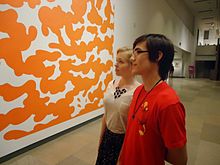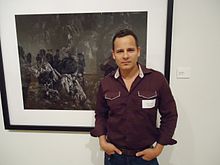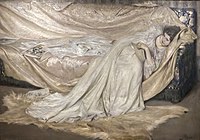 | |
 Phoenix Art Museum's north entrance Phoenix Art Museum's north entrance | |
| Established | 18 November 1959 (1959-11-18) |
|---|---|
| Location | 1625 North Central Avenue Phoenix, Arizona 85004 United States |
| Coordinates | 33°28′00″N 112°04′22″W / 33.466749°N 112.072655°W / 33.466749; -112.072655 |
| Type | Art museum |
| Public transit access | |
| Website | www |

The Phoenix Art Museum is the largest museum for visual art in the southwest United States. Located in Phoenix, Arizona, the museum is 285,000 square feet (26,500 m). It displays international exhibitions alongside its comprehensive collection of more than 18,000 works of American, Asian, European, Latin American, Western American, modern and contemporary art, and fashion design. A community center since 1959, it hosts festivals, live performances, independent art films and educational programs year-round. It also features The Hub: The James K. Ballinger Interactive Gallery, an interactive space for children; photography exhibitions through the museum's partnership with the Center for Creative Photography; the landscaped Sculpture Garden; dining and shopping.
It has been designated a Phoenix Point of Pride.
History
Opened in 1959, the Phoenix Art Museum is located on the Central Avenue Corridor.
Shortly after Arizona became the 48th state in 1912, the Phoenix Women's Club was formed and worked with the Arizona State Fair Committee to develop a fine arts program. In 1915, the club purchased Carl Oscar Borg's painting Egyptian Evening for US$125 and presented it to the city of Phoenix to begin a community art collection. In 1925, the State Fair Committee expanded its community responsibilities and formed the Phoenix Fine Arts Association.
The next major advance in the local art community came during 1936, when the Phoenix Art Center was created under the auspices of the Works Progress Administration's Federal Art Project. Its director was the painter Philip C. Curtis. Its success led to the creation in 1940 of the Civic Center Association, which set about raising funds and planning a building on a 6.5-acre plot donated by the heirs of Adolphus Clay Bartlett. These heirs included Maie Bartlett Heard, who with her husband Dwight B. Heard founded the Heard Museum.

In the early 1950s, Alden Dow, an architect, was retained by the board of trustees to design a complex that would house the Phoenix Public Library, the Phoenix Little Theater (now the Phoenix Theatre) and the new Phoenix Art Museum. The structural engineering firm chosen for this project was Severud Associates. To coordinate this endeavor, the Phoenix Fine Arts Association named a new board of trustees in 1952 and the museum's first director, Forest M. Hinkhouse, in 1957.
The museum opened on November 18, 1959, and was officially dedicated on November 21, 1959. Two years later, the board announced plans for an expansion, and in 1965 the museum was enlarged from 25,000 square feet (2,300 m) to 72,000 square feet (6,700 m). Additional expansions, led by design architects Tod Williams Billie Tsien Architects of New York, occurred in 1996 and 2006. The museum more than doubled its size with new exhibition galleries, a 300-seat public theater, a research library, studio classroom facilities, the PhxArtKids Gallery, and a café. Most recently, in 2006, the museum saw the opening of the Ellen and Howard C. Katz Wing for Modern Art, the Heather and Michael Greenbaum Museum Lobby, an expanded museum store and the 40,000-square-foot (3,700 m) Bennett and Jacquie Dorrance Sculpture Garden. A new entrance from the north parking includes a cantilevered canopy, creating a large outdoor pavilion area. The museum's growth has been funded, in part, by successful City of Phoenix Bond Elections and a voter-approved bond.
In the last 50 years, the museum has hosted more than 400 exhibitions from all over the world, grown the collection to more than 18,000 works of art, and been visited by millions.
Collections




In addition to an annual calendar of exhibitions, the museum's permanent collection galleries are drawn from more than 19,000 works of American, Asian, European, Latin American, Western American, modern and contemporary art, and fashion design. Visitors also enjoy photography exhibitions through the museum's landmark partnership with the Center for Creative Photography, University of Arizona.
The museum has European paintings by Ubertini, Girolamo Genga, Guercino, Carlo Dolci, Bernardo Strozzi, Marcellus Coffermans, Jacob Cornelisz, Master of Astorga, Bartolomeus Bruyn the Elder, Nicolas Lepicie, Giovanni Piazzetta, Elizabeth Vigee-Lebrun, Antoine Vestier, George Romney, Camille Corot, Hippolyte Delpy, Eugène Boudin, Jean-Léon Gérôme (Thumbs Down), Claude Monet (Garden Arches, Giverny), Max Beckmann, Léon Portau, Édouard Vuillard, and Pablo Picasso. It has American paintings by Gilbert Stuart, Sanford Gifford, Robert Henri, Ernest Lawson, Marsden Hartley, Stuart Davis, Georgia O'Keeffe, Jonas Lie, Lew Davis, Ernest Blumenschein, Joseph Sharp, Howard Post, and Ed Mell. It has contemporary art by Yayoi Kusama (You Who Are Getting Obliterated in the Dancing Swarm of Fireflies), Viola Frey, Donald Martiny Kehinde Wiley, Carlos Amorales (Black Cloud), and Helen Frankenthaler. It has 20th Century Sculpture by Aristide Maillol, Max Ernst, Hans Arp, Jacob Epstein, and Giacometti.
Education
The museum offers several educational programs. The museum's Education Division programming is segmented by audience and type of learning strategy to accommodate a range of ages and learning styles, both formal and informal.
The Education Division also facilitates a nationally competitive Internship program. Internships are offered to current undergraduates, graduate students, and recent graduates with requisite coursework, experience, and background. The program is offered year-round and project-based internships are also offered on occasion.
Lemon Art Research Library
The Lemon Art Research Library is a non-circulating research library with an emphasis on the museum's art collection. It contains more than 40,000 books, periodicals, artist files and more. It is the largest specialized fine arts library in the region. It is free of charge during public hours.
Funding
Community support accounts for approximately 80% of the museum's revenue through admissions, membership and earned revenue, which includes the store and facility rentals. Government support of the museum is approximately 3% of the budget; corporate contributions constitute approximately 10% of the budget. The museum's endowment contributes the remainder, approximately 7%.
Gallery
-
 Adelaide Labille-Guiard, Madame Adelaide, 1791
Adelaide Labille-Guiard, Madame Adelaide, 1791
-
 Jean-Léon Gérôme, Thumbs Down, 1872
Jean-Léon Gérôme, Thumbs Down, 1872
-
 Julius LeBlanc Stewart, Spring Flowers, 1890
Julius LeBlanc Stewart, Spring Flowers, 1890
-
 Eugene Boudin, The Old Harbor at Touques, 1891
Eugene Boudin, The Old Harbor at Touques, 1891
-
 Antonio Rizzi, Study in White, 1896
Antonio Rizzi, Study in White, 1896
-
 Edouard Vuillard, Madame Hessel Working at a Dressmaker's Table, 1908
Edouard Vuillard, Madame Hessel Working at a Dressmaker's Table, 1908
-
 Willard Franklin Midgette, Processing Sheep, 1976
Willard Franklin Midgette, Processing Sheep, 1976
-
 Kenneth Riley, Bodmer Painting Piegan Chief, 1986
Kenneth Riley, Bodmer Painting Piegan Chief, 1986
See also
References
- ^ Phoenix Art Museum: About, ARTINFO, 2008, retrieved 2008-07-24
- "Communications Office Points of Pride". www.phoenix.gov. Retrieved 2019-02-28.
- "History and Mission". About Us. Phoenix Art Museum. Archived from the original on 2017-10-06. Retrieved 2015-06-21.
- "History of the Heard Museum". Heard Museum. Retrieved 2015-06-21.
- Komanecky, Michael; Ballinger, James K (2002). Phoenix Art Museum : collection highlights. New York: Harry N. Abrams in association with Phoenix Art Museum. ISBN 0810932458. OCLC 48957880.
- pls4e (2018-09-06). "Phoenix Art Museum". SAH ARCHIPEDIA. Retrieved 2022-03-24.
{{cite web}}: CS1 maint: numeric names: authors list (link) - "Williams Tsien Phoenix Art Museum". the PhotoPhore. 2015-08-18. Retrieved 2022-03-24.
- "History and Mission". Phoenix Art Museum. Retrieved 2018-07-12.
- "History and Mission". Phoenix Art Museum. Retrieved 2019-02-27.
- "European".
- "Phoenix Art Museum American Collection". Phoenix Art Museum. Retrieved 2018-07-12.
- "Yayoi Kusama at Phoenix Art Museum". Phoenix Art Museum. Retrieved 2018-07-12.
- "Donald Martiny: Biography – Selected Collections". www.madionsgalleries.com. Retrieved 2022-02-11.
- "Carlos Amorales at Phoenix Art Museum". Phoenix Art Museum. Archived from the original on 2018-07-11. Retrieved 2018-07-12.
- "Contemporary".
- "Modern".
External links
- Phoenix Art Museum website
- Phoenix Points of Pride
- Museums in Phoenix, Arizona
- Institutions accredited by the American Alliance of Museums
- Art museums and galleries in Arizona
- Works Progress Administration in Arizona
- Art museums and galleries established in 1959
- 1959 establishments in Arizona
- Alden B. Dow buildings
- Asian art museums in the United States
- Federal Art Project